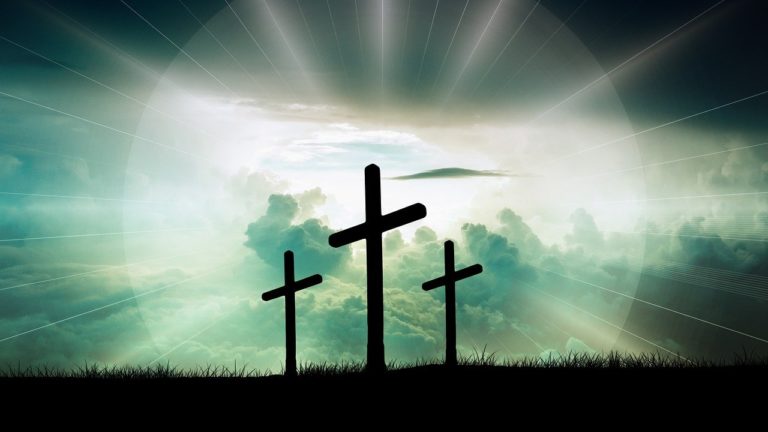*This post may contain affiliate links and ads. As an Amazon Associate I get a commission from any qualifying purchases.*
The word gospel means good news, and is a term used to define the four written accounts of Jesus of Nazareth in the New Testament. The four widely known gospels are the canonical gospels of Matthew, Mark, Luke, and John. However, the term can also refer to the apocryphal, non-canonical, the Jewish, and the gnostic gospels. There are several accounts of Jesus that are not recognized or accepted by Orthodox Christians, however the gospels of Matthew, Mark, Luke, and John are going to be my focus in this article.
Despite the gospel of Matthew being the first book in the new testament the majority view today, is that Mark was actually the first gospel followed by Matthew and then Luke. It is believed that Matthew and Luke borrowed passages from Mark’s gospel and one other hypothetical source commonly referred to as source Q, which has been lost to history. This view is known as the two-source hypothesis, which came out around the 19th centruy. Source Q is thought to contain sayings of Jesus. Matthew and Luke copied source Q’s content in the same order, but changed the wording to make it easier for their audiences to understand. The fact that Mark does not contain anything from source Q and very little of Mark is found in Luke it’s a good bet that Mark was the first gospel account written.
Due to Matthew and Luke borrowing passages from Mark these three gospels are known as the synoptic gospels. Synoptic means having the same view, and if you read the gospels of Matthew, Mark, and Luke you will understand why they are considered the synoptic gospels. They contain much of the same information in the same order. John was the only author who actually knew Jesus on a personal level and his gospel takes a different view than the first three. John’s gospel follows a very different time line and does not share much content with the other three gospels. The gospel of John uses different verbiage, style of writing, and was actually rejected by the Orthodox Christians for a long time. Today, it is widely accepted and is the favorite gospel among conservative Christians.
Below you will find a comparison table that helps to better visualize some of the main differences and similarities between the four gospels.
| Authors | Writer Info | Date Written | Who was Jesus | Audience | Historical Context |
| Mark | A 2nd generation Christian | 65-70 CE/AD | Healer, Miracle worker, Teacher, Misunderstood by those close to Him | Gentile Christian’s in Rome under presecution | Romans restrained Jewish rebellions & Christians experienced prosecution in Rome |
| Matthew | Unknown Jewish Christian | 75-80 CE/AD | Promised Messiah of Jewish people, greatest prophet, | Jewish Christians | Written after Romans had destoryed Jerusalem |
| Luke | Gentile Christian | 80-85 CE/AD | Merciful, Compasionate, showed special concern for women, the poor, & non-Jews | “Theophilus” (Friend of God) | Heavy pursecution of Jews & Christians |
| John | The “Beloved Disciple” | 90-110 CE/AD | Noble, Powerful Devine | Jew, Gentiles, and Samaritans | Christians banned from synagogues |
Terms to Remember
- Covenant: An agreement between God and His people
- Synoptic: Forming a general synopsis. Relating to the Synoptic Gospels
- Testament: Bears witness to
- Canonical: The official 27 books of the New Testament
- Non-Canonical: Books that were deemed unnecessary for the New Testament. These writings are separate from the apocrypha
- Apocrypha: Anonymous and thought to be mostly uninspired by the Divine. These works are still considered to be worthy of study by Protestants
- Deuterocanonical: A subset of Apocrypha works, Deuterocanonical describe works that are used by Catholics & Orthodox Christians. An example of this would be the Canonical’s of the Catholic church/bible. The Catholic bible includes the books of Tobit, Judith, Baruch, Sirach, 1 & 2 Maccabees, and the book of Wisdom. Eastern & Oriental Othodox churches as well as the Assyrian church contain Deuterocanonicals.
- Pseudepigrapha: False attribution. This means text whose claimed author is not the person who actually wrote the work. In some cases the author will attribute their work to a person in the past.
- Theophilus: Lover of God
The Gospel According to Mark
It is believed that Mark wrote out of Rome. His book is unique in that he’s very brief and to the point. Mark’s gospel is by far the shortest at only 16 chapters. No where in his accounts does he talk about the genealogy of Jesus or talk about the story surrounding His birth. Despite being the shortest gospel Mark focus roughly 40 percent of his account on the Passion and the events surrounding Jesus’ death. Interestingly enough, it is also believed that Mark did not write about the events that happened after the resurrection. My bible, like many others, contains this note “The earliest manuscripts and some other ancient witnesses do not have Mark 16:9-20”.
His gospel’s focus is on the idea that Jesus was a servant. This can be seen by his lack of recording Jesus’ geneology. Mark’s work is meant to encourage Christians throughout Rome, despite the persecution they are enduring for their faith. He goes on to say that persecution is the price that Christian’s must pay for following Jesus. In the book of Mark, Jesus says “…Whoever wants to by my disciple must deny themselves and take up their cross and follow me. For whoever wants to save his life will lose it, but whoever loses his life for me and for the gospel will save it.'” (Mark 8:34-35).
The Gospel According to Matthew
Matthew is believed to be writing from Antioch of Syria. He was writing to and for the Jews and focuses his work around the idea that Jesus is the King of the Jews. We can see a great example of this very early on. Matthew 2:2 says “Where is the one who has been born king of the Jews? We saw his star in the east and have come to worship him.”
There were two main reasons Matthew wrote his book. The gospel of Matthew was written as a message of strength and encouragement to the Jewish Christians. Despite Jesus being killed by Jews, Matthew’s first message is to strengthen Jewish Christian’s faith in the knowledge that Jesus was the Messiah for all people. To prove that Jesus was the promised Messiah of the Old Testament, Matthew quotes the Old Testament more than the other synoptic authors Mark and Luke.
The second reason he writes his book is to show that Jesus was truly the Messiah. He shows this by recording Jesus’ geneology and quoting the old testament. “A record of the geneology of Jesus Christ the son of David, the son of Abraham:” (Matthew 1:1). This verse fulfills the prophecy from 2 Samuel 7:12-14 “When your days are over and you rest with your fathers, I will raise up your offspring to succeed you, who will come from your own body, and I will establish his kingdom. He is the one who will build a house for my Name, and I will establish the throne of his kingdom forever. I will be his father, and he will be my son.”
The Gospel According to Luke
Luke wrote from Caesarea or possibly Rome. He was known to be an accurate historian, and as a result he carefully researched everything before composing his gospel. Luke approaches his work by making Jesus the Son of man. This means he frequently shows Jesus’ human traits and how he showed a genuine interest in the people he came across no matter their ethnicity. Luke also spends ample time focusing on Jesus’ birth and childhood. The first two chapters are dedicated to the history and geneology of Jesus. He goes as far as to suggest that Jesus belongs not to the Jews, but to the whole world. Jesus’ world wide mission of spreading Christianity to both Jews and Gentiles is not only recorded in the gospel of Luke, but is further expanded on in the Book of Acts which is also written by Luke.
Many of Luke’s other versus portray a Jesus who was able to feel human emotions as well as express other human traits like feelings of pain, hunger, and sorrow.. “Jesus, full of the Holy Spirit, returned from the Jordan and was led by the Spirit in the desert, where for forty days he was tempted by the devil. He ate nothing during those days, and at the end of them he was hungry” (Luke 4:1-2). “He withdrew about a stone’s throw beyond them, knelt down and prayed, ‘Father, if you are willing, take this cup from me; yet not my will, but yours be done.’ An angel from heaven appeared to him and strengthened him. And being in anguish, he prayed more earnestly, and his sweat was like drops of blood falling to the ground.” (Luke 22:41-44).
The Gospel According to John
The gospel of John was the only gospel written by a follower of Jesus and was likely written in Ephesus. The other three writers were followers of Jesus’s apostles, and likely never met Jesus for themselves. John’s message is a personal account of his life where he closely followed Jesus. Therefore, John’s message is for all peoples and his whole purpose for writing is to bring forth evidence to prove that Jesus is Christ and truly is the Son of God.
The theme of his gospel is emphasizing the divine status of Jesus. This can be seen through Jesus’ statements of “I am” that are found all throughout John’s gospel. From the very first verse to the last, John’s message of divinity is very clear. In John 1:1 he lays the foundation for his entire gospel, “In the beginning was the Word, and the Word was with God, and the Word was God”. The last verse John 20:31 the message of his gospel is portrayed in black in white; “But these are written that you may believe that Jesus is the Christ, the Son of God, and that by believing you may have life in his name”. If there was ever any doubt, John blows that doubt out of the water and spends 20 chapters emphasizing the fact that Jesus is God.
Gospel Symbol’s
Each of the gospel’s symbols is referenced in Ezekiel 1-2 as well as Revelation. These symbols can also be seen in early medieval gospel books as well as on today’s church portals (doors/gates/pillars) or ceilings.
- Matthew – An angel or winged man. This is thought to represent the ancestry of humans as the book of Matthew talks heavily about the genealogy of Christ. It could also representative of Jesus’ incarnation.
- Mark – A Winged lion. Mark talks about the resurrection of Christ, and it was once believed that lions slept with eyes open which can be equated to Christ in the tomb. The lion also signifies how Christians should walk in their faith on their path to salvation (with courage).
- Luke – A winged ox/bull. Luke’s focus is on the sacrifice of Christ. Oxen were commonly sacrificed animals and therefore are used as the symbol for Luke. The ox is also the symbol of strength, and service which signifies that Christians should be ready to endure sacrifices while following Jesus.
- John – An eagle. It is believed that the eagle represents the highest of inspiration. John is believed to have written several books of the Bible, so his gospel is symbolized by the eagle. John’s gospel also goes deeper into “higher” Christology by focusing on Christ’s divine nature.
Final Thoughts
Despite each gospel being composed in different locations and for an array of audiences experiencing different historical situations, they have similar story lines and ideas of Jesus’ life. Jesus’ character and history are portrayed slightly different in these works however, they do not contradict each other. The different works compliment and provide a harmonious detailed description of Jesus’ life on Earth.
Mark’s gospel is the shortest at only 16 chapters and is a great place to start studying the synoptics, because it contains a lot of the same information as Matthew and Luke. John is the second shortest at 21 chapters and would be another great place to start if you’re looking for a more personal look into Jesus’ life and purpose on Earth. Luke has 24 chapters and Matthew is by far the longest with 28. No matter where you start, there is no question you’ll find be inspired by the word of God.


